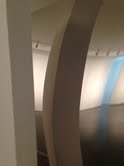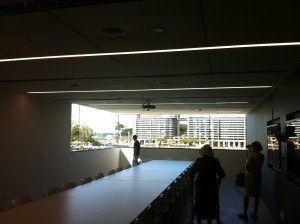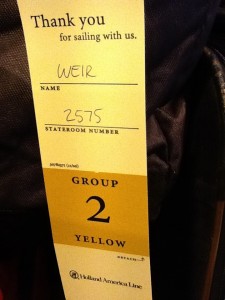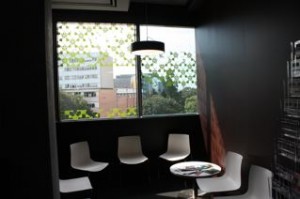
25.03.2013
Anish Kapoor @ MCA
Finally had the opportunity to Visit the Anish Kapoor Show at the MCA, the last days posters were up so I knew I had to make it and of course, I wasn't disappointed. As a lighting designer the way we see is a cornerstone to the way we approach lighting design. Kapoor intrigues you with his investigations into our optic system, repeatedly confusing your eye/brain link. The viewer constantly asking themselves, (often unconsciously) "how is it so?"
The convex coloured discs reflect back the clean gallery walls & floor. Your eyes/brain struggle to find an edge. Edges give meaning and perspective to your world. Without edges you see nothing you can't comprehend anything. So you see the reflections of the walls and floor as a flat mirror, an additional plane to the curved artwork, when you know there is in fact none. Your brain tries so hard to make sense if it that you even believe you can even see the shadow the imagined internal disc creates. (See image)
Your brain is having so much difficulty in trying to recognise or process what
you're seeing you suffer a sense of "mal de mer" or nausea. Again &
again you have to move around to the side of the artwork to check
to see if it is mounted flush to the wall or as your eyes/brain would have it off the wall.

Although fascinating and enjoyable I had the slightly unnerving feeling that is somehow akin to a carny sideshow or magician's act. Where its too clever by half  But its impossible to ignore how Kapoor can connect with a wide ranging audience. And good luck to him. 4 out of 5 light globes
But its impossible to ignore how Kapoor can connect with a wide ranging audience. And good luck to him. 4 out of 5 light globes

12.03.2013
Magic light Garden at Centennial Park

09.10.2012
ParkLight 2012 @ Sydney Uni
Parklight, held in late August, was the 4th exterior lighting event organized by the NSW IES lighting society and the first to be run in conjunction with Sydney University’s Department of Illumination. It assembled together over 50 eager participants; lighting designers, architects, students and lighting suppliers to meet, discuss and experiment with lighting techniques and the equipment used in exterior lighting. Electrolight lighting designer and event organiser Ryan Shamier described the event as “a wonderful excuse for suppliers and designers to collaborate and share ideas” The theme of this years event was 'winter wonderland". Participants were fashioned into 6 groups: ice, blizzard, snow, frost, chill & cold, provided with a range of exterior luminaires, then allocated a predetermined location around the Gadigal Green at Sydney University. Their challenge was to improvise and problem solve within their group, using the donated equipment to design and light a winter themed tableau. Groups went off on their task and quickly dissected the opportunities that different luminaires provided. This hands on approach allowed participants to use the luminaires in a range of settings and applications, exploring each lamp’s potential and the effects of colour, beam angles and reflector types. Judging was conducted by a show of hands, with all attendees casting their vote for their favourite lighting design.
Versalux Zumtobel With a very special thank you to Wendy Davis and the University of Sydney (Faculty of Architecture) for hosting the event. .
31.08.2012
It looks different under this light
Here is a prime example of how the choice of the wrong type of luminaire can create problems in efficient business management. Admittedly this is a situation where the original workplace has morphed into a different role, but never the less it demonstrates how lighting plays an important role in the efficient functioning of any business. In this case Baggage handlers sorting passengers luggage. The luggage labels are colour coded. Lamps with poor colour rendering properties, like sodium vapour, do not reveal the true colour of the labels. This means in an environment where sorting has to be done at speed, red, orange and yellow labels can often be confused. Where work tasks require colour discrimination, such as fabric choice, graphic or printing workspaces even make up salons, luminaire selection should always prioritise the colour rendering properties of the luminaire. For the right advice on lamp selection for your home or business contact LightBureau at info@lightbureau.com.au
11.07.2012
6.5 billion People livin’ in the burbs.
70% of the world’s population will live in newly built urban areas by 2050. Do you think planners will use the Australian defacto model, i.e. big houses, big highways, big energy bills? Here is my report from the Green lighting expo, afternoon session, 26th of April 2012 Intelligent lighting for a dreaming and sustainable city: Yongquin Zeng from Phillips Research Asia The afternoon session was the highlight of the expo. The focus was on the increased urbanisation of the developing world. The figures released show an estimated 6.5 billion people will live in newly built urban areas by 2050, that’s over 70% of the world’s population. Increased urbanisation creates a dynamic matrix of needs. Infrastructure projects will require heavy investment in energy management and this is where the increasing demands for street lighting and city lighting for safety and amenity will provide large markets for producers of advanced SSL products. The main driver of this growth will be energy use and how you are billed for that energy use. In a low carbon economy billing has to reflect usage, and energy suppliers want to make more money in an era where they may be taxed on their emissions. Street lighting has been established in China since the birth of Christ. Recently china has added 14 million road lamps to the existing system and predicts growth in road lighting of about 10% p.a and energy increase of around 8%. Yangzhou province added 6 million road lamps in 5 years! Existing road lamps are based on clock control systems, modern lamps will be microchip controlled. Beijing began cities survey in 2008...intelligent services industry included road lighting as part of their system platform the outcomes provided interesting insights in the future. To be energy efficient city there needs to be an aggregation of services. All homes, buildings and public spaces will need to be inter-connected. For example: Urban Traffic: Intelligent Management and Information Services In the urban traffic field, advanced information technologies, data transmission technologies, electronic control technologies and computer processing technologies will be applied to traffic and transportation to establish an informatized, intelligentized and socialized system, which provides citizens with multiple services and enhance the security, energy-efficiency and effectiveness of urban traffic through the collection, processing, distribution, exchange, analysis and utilization of information. The specific tasks include smart traffic signal control system, traffic video analysis and monitoring system, e-police system, automatic entry control monitoring system, dynamic traffic guidance information system, smart logistics information platform, goods tracing and positioning system, as well as process visualization and smart management system. http://www.businesswire.com/news/home/20110811005474/en/CCID-Consulting-Development-Sensory-Cities-Ramps-China This will lead us into the “internet of things”…
14.04.2012
Get away for the weekend
 Was lucky to get away for the weekend and stayed at a converted caravan park, Moby’s, a resort on the beach 3 hrs north of Sydney. Pleasant enough accommodation but laying here in bed early morning, (what a luxury), just might read the paper in bed, but the bedside light is too soft to provide enough illumination to read by. Although there is a large window in the bedroom it is well shaded by palms and so little light seeps through, reluctantly I’m forced to resort to the overhead ceiling recessed down light, an incandescent par style fixture in the middle of the ceiling. Huge mistake, there is so much glare from the lamp, just above your eyeline, to make reading almost make it unbearable. In fact it is unbearable. The room also has a disastrous mix of colours, daylight and tungsten CFL’s.
Walking through the resort last night I found the use of daylight lamps in the bollards lining the roadway/footpath disturbing, they’re too cold and unattractive for my liking. I wondered whether the designer had chosen daylight colour because of the exterior colour palette used with the accommodation, that blue beach and timber cottage feel. I still feel in a hospitality setting tungsten 3200 K is usually the appropriate choice
Was lucky to get away for the weekend and stayed at a converted caravan park, Moby’s, a resort on the beach 3 hrs north of Sydney. Pleasant enough accommodation but laying here in bed early morning, (what a luxury), just might read the paper in bed, but the bedside light is too soft to provide enough illumination to read by. Although there is a large window in the bedroom it is well shaded by palms and so little light seeps through, reluctantly I’m forced to resort to the overhead ceiling recessed down light, an incandescent par style fixture in the middle of the ceiling. Huge mistake, there is so much glare from the lamp, just above your eyeline, to make reading almost make it unbearable. In fact it is unbearable. The room also has a disastrous mix of colours, daylight and tungsten CFL’s.
Walking through the resort last night I found the use of daylight lamps in the bollards lining the roadway/footpath disturbing, they’re too cold and unattractive for my liking. I wondered whether the designer had chosen daylight colour because of the exterior colour palette used with the accommodation, that blue beach and timber cottage feel. I still feel in a hospitality setting tungsten 3200 K is usually the appropriate choice
]One of the areas underutilized by modern architects and designers is in the area of Post Occupation Evaluation. Convincing companies and organizations to commit to POE’s after a job has been signed off can be a daunting task because there is a general malaise around the office and a feeling that all the hard work has been done. Most practitioners have “shut the book” and moved onto other projects… But the importance of reviewing your work to maintain & uphold professional integrity is recognized in all specialized fields. Without proficient peer review, mistakes can be repeated, ideas stagnate and of course, most importantly, the end user, your client’s wishes ignored. Here at the Lightbureau, with a background in communication and culture studies, (Literature Language and Culture Curtin University, 1998) we have been conducting Post evaluation studies to discover the positive and negative outcomes of architectural design with an emphasis on lighting. By compiling site specific questionnaires and conducting personal and group interviews with end users, Lightbureau have produced detailed summaries that ensure designers, architects and engineers fully evaluate their projects’ success or failures. “The POE questionnaire will give an indication of what the users think of the building as a whole, of its interior work environment, including noise and thermal conditions, and especially how the lit environment is experienced and how well the users think that the lighting and daylighting control systems work. … A systematic survey of the users' attitudes to the indoor environment can help to understand the merits and problems of daylighting systems and controls as adapted to the specific building and the conditions created by the building design and the use of the building. Dissatisfaction expressed should be used to try to understand where and why problems are found. In this way potential changes can be made to improve the indoor environment…The users’ reactions should also be used as indicators to problems that could be solved by readjusting something technical or rearranging work place layout, i.e. not just be regarded as a negative outcome of the POE. This could be the most efficient way to find out where problems are before they have led to more severe problems like fatigue, strained muscles or even sick leave. Reference: POE Post occupancy evaluation of daylight in buildings A Report of IEA SHC TASK 21 / ECBCS ANNEX 29 International Energy Agency: Energy Conservation in Buildings and Community Systems Program In particular Lightbureau will focus analysis on the success of the PR and marketing of the project ensuring the companies integrity and status within the community. 1. “An improved indoor environmental quality is substantiated with maximising daylight ingress and occupant daylight control. The open planned workstations and meeting spaces have been strategically designed along the perimeter zoning, with private offices and service zones located in the central spine of the floor plates. Zoned office lighting has also been adopted an alternative initiative to increased energy efficiency and user control.” 2. “Offices in the superstructure are offered individual customisation of light, air and views, lowering energy use.” 1. IN THE ARCHITECTS WORDS http://www.architecture.com.au/awards_search?option=showaward&entryno=2009023413 2. 2009 NSW Architecture Awards | Jury Citations Below are some examples of our approach and conclusions drawn: LIGHTING CONDITIONS SURVEY: The aim of this survey is to gauge the occupants’ opinion of the lighting conditions in their work place environment. The survey complements measurements of daylight and artificial light. Please complete and return the questionnaire as you are instructed. Please complete your survey from where you perform most of your job tasks (your work station). Please do not look directly into luminaries when asked questions about the office lighting. Be frank and honest in your answers. Your answers will only be used as part of a statistical analysis of our survey. A review of the lighting parameters set by AS1680.2.2: 2008 reveals that most considerations for the lighting designer have been met, however, as remarked earlier, due to the bias already noted in emails the questionnaire will focus on sections 10.2 Daylighting Systems of the AS1680.1: 2006, and Section 3.5.5, Visual Comfort of AS1680.2.2: 2008 Here are an example extracts from our surveys: ....Participants spent all day in their office and were at their workstation for at least half that time. All used the PC for most tasks, the second most common activity being reading. Good light was the most important feature “most important to you in making a work place a pleasant one for you to work in”, followed by good ventilation and comfortable temperature. During my appraisal of the office there was a 1 degree temperature difference between workstations placed along side windows to those nearer the internal corridor. …. It appears that even though the building conforms to the most exacting of contemporary standards and has been rewarded as such, a lack of adequate daylight design and planning, in particular the failure to implement the recommendations of AS/NZ1680.1:2006, Section 10.2.6 Glazing Recommendations. AS/NZ1680.1:2006 “Therefore tinted and reflective mirrored glazing should not be considered as a general strategy in the design of daylighted interiors.”

The copying centre located off the corridor. Recessed task lighting, (T5’s) and a change from overhead linear fluorescents to CFL downlights

10.04.2012
Mordant wing of the MCA Lighting

 Recently I visited the newly opened Mordant wing of the MCA to look at the lighting.
Recently I visited the newly opened Mordant wing of the MCA to look at the lighting.
I app
roached the George street entrance. To me it has been presented with rather tacky façade. It looks as thought the building is still under construction and covered in dirty, dusty, faded hoarding timbers. However, that may be the intended effect?
Further investigation revealed the idea mighthave been to hide a previous extension that no one liked.
The entrance Signage captures the essence of modernity, the way how it curves under façade, but its outline is soft, lacking in contrast resulting in a reduction init’s profile. It’s weird that it's lit with tungsten colour when the power of full daylight completely bleaches it out away. At night it may look more attractive and match the tones of the building façade. Whatever the colour choice the lighting should be on a timer or daylight sensor. When I entered the library there were no artificial lights on, when quizzed why the attendant sitting at the desk replied ' I don't even know where the switches are?'
When I entered the library there were no artificial lights on, when quizzed why the attendant sitting at the desk replied ' I don't even know where the switches are?'









